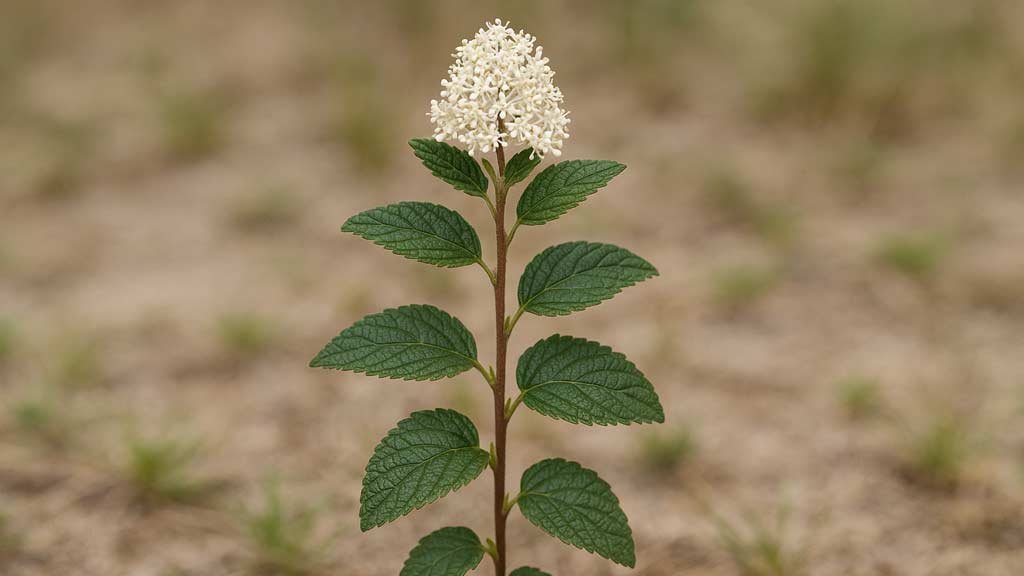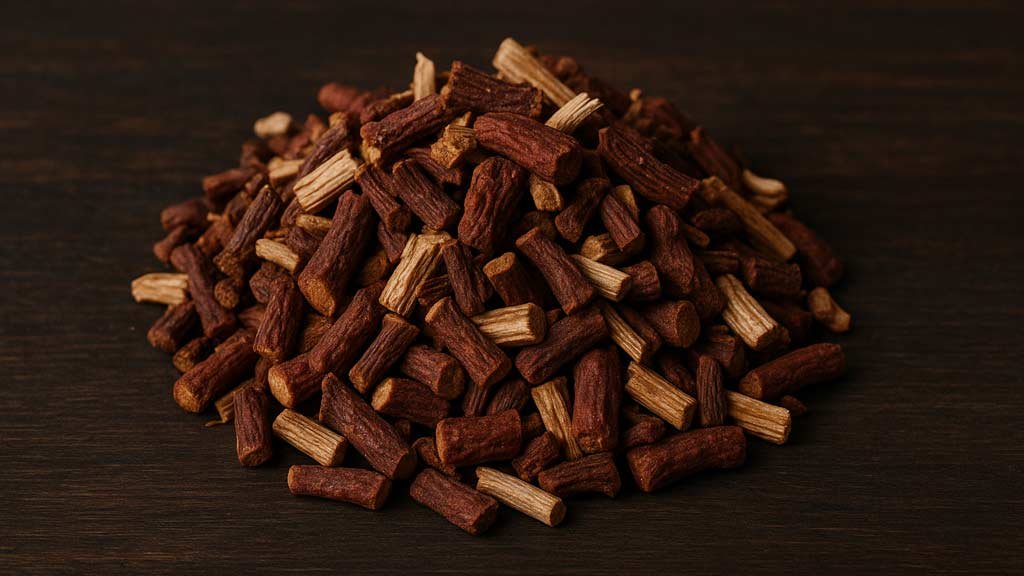A Quiet but Potent Herb
Red Root, also known as Ceanothus americanus or New Jersey Tea, isn’t the kind of herb that shouts for attention. It’s subtle. The plant itself looks like an ordinary shrub, with small white flowers and a modest presence on hillsides or woodland edges. Yet when you start working with it, you quickly learn that its power runs deeper than its unassuming appearance. Herbalists have long turned to Red Root for lymphatic congestion, sluggish digestion, and a kind of grounded energy that comes from helping the body move waste where it needs to go.
You don’t hear about it in the same breath as echinacea or ginger, but that’s part of the charm. Red Root sits in the background, doing essential work most people don’t notice until something goes wrong.
Table of Contents
What Exactly Is Red Root?
Red Root belongs to the buckthorn family, though unlike many of its relatives it has a strong medicinal history. Indigenous peoples used it for respiratory issues, digestive complaints, and as a poultice for wounds. Later, during the American Revolution, it even served as a tea substitute when imported black tea became scarce—hence the nickname “New Jersey Tea.”
The root, unsurprisingly, is the part most often used in medicine. When cut or broken, it bleeds a reddish tint that explains the name. The root is tough, gnarled, and deeply anchored, much like the systems in the body it seems to support—those hidden networks like the lymph and intestines that keep us alive but rarely get the spotlight.
Red Root and the Lymphatic System
The lymphatic system is the body’s quiet janitor. It clears cellular waste, moves immune cells, and helps fluids cycle back into circulation. When it bogs down, you feel it: swollen glands, sluggish energy, maybe even that heavy, foggy sensation after being sick. Red Root has earned its reputation as a lymphatic tonic because it seems to nudge this system back into motion.
Some herbalists describe Red Root as a “decongestant” for the lymph. It doesn’t act like caffeine or stimulants—it’s gentler, more like opening a blocked stream so the water can run freely again. Traditionally, it has been used for:
- Enlarged lymph nodes after infections
- Congestion in the spleen and liver
- Supporting the recovery process from viral illnesses
- General immune resilience by keeping waste moving
One story comes from a herbalist who worked with people recovering from mononucleosis. They noted how swollen lymph nodes shrank and energy levels improved when Red Root tincture was introduced alongside rest and nourishing food. That’s anecdotal, yes, but it echoes hundreds of years of traditional use.
Red Root and Digestion
Digestion isn’t just about the stomach. The liver, spleen, and intestines all have their say in the process. Red Root supports these organs by reducing congestion and improving the way bile and fluids move.
For people who feel boggy after meals, with a sense of heaviness in the abdomen, Red Root can be a welcome addition. Its astringency tones tissues, which can help if digestion feels weak or overly sluggish. Some traditional uses include:
- Supporting liver detoxification
- Easing abdominal fullness after rich meals
- Helping with malabsorption tied to lymphatic congestion
- Toning the gut lining when things feel too loose or inflamed
It’s not a magic pill, but think of it like clearing a roadblock so traffic can flow. The food moves, nutrients absorb, and waste exits without as much strain.
The Energetics of Red Root
If you’ve ever worked with herbs beyond the chemical analysis, you know each plant carries an energetic signature. Red Root feels grounding. Its taste is tannic, earthy, and a little drying. That matches its action—it draws things together, tones slack tissues, and directs movement downward and inward.
In energetic terms, Red Root suits people who feel stuck, sluggish, or bogged down in their fluids. You see it in folks with chronic congestion, swollen glands, or a belly that just won’t empty comfortably. It’s not for someone dried out and frail—it’s for the person with too much damp, too much stagnation.

How Red Root Is Used
Preparation matters. Red Root is tough and woody, so tinctures and decoctions are the main ways it’s taken.
- Tincture: A common method. Made from the root in alcohol, it extracts well and keeps for years. Typical dosage runs from a few drops up to a full dropper, taken 2–3 times daily.
- Decoction: Simmer the dried root in water for 20–30 minutes. The resulting tea is strong, bitter, and earthy—not a casual sipping tea, but deeply medicinal.
- Powder: Less common, but some people dry and grind the root, taking it in capsules.
Externally, poultices of the root have been used for skin issues, but internal use remains the main practice.
Red Root in Combination with Other Herbs
Rarely do herbalists use Red Root alone. It pairs beautifully with herbs that share its affinity for the lymph, liver, or digestion. For example:
- With Echinacea during acute infections, to keep lymph moving.
- With Cleavers for gentle daily lymphatic support.
- With Dandelion Root to boost liver and digestive function.
- With Calendula for addressing tissue inflammation alongside lymph congestion.
Each pairing brings a different nuance. Alone, Red Root is firm and grounding. Together, it harmonizes with lighter herbs to balance out the picture.
A Note on Safety
Every herb carries considerations. Red Root is generally safe in moderate doses, but because it moves fluids and tones tissues, it may not be ideal during pregnancy or for people with very dry constitutions. High doses can cause nausea or upset digestion. Start small, notice how your body responds, and adjust.
It’s also worth noting that while Red Root has traditional use for serious conditions like spleen enlargement or chronic hepatitis, it’s not a substitute for medical care. Think of it as a supportive ally, not a replacement for diagnosis and treatment.
Red Root and Modern Herbalism
In today’s herbal circles, Red Root occupies an interesting place. It’s not mass-marketed or trendy. You won’t see it in supermarket teas or flashy supplement ads. Instead, it remains a trusted herb for those who dig a little deeper—clinical herbalists, traditional healers, and people who’ve discovered its effects through word of mouth.
That under-the-radar quality means it hasn’t been studied as heavily as some herbs. You won’t find dozens of clinical trials. But what you do find are generations of consistent use, backed by the testimony of people who notice their swollen glands ease, their digestion smooth out, and their sense of heaviness lift. Sometimes, that kind of quiet, lived experience carries weight.
Growing and Harvesting Red Root
For those who like to connect with their medicine from the ground up, Red Root can be grown in many regions of North America. It prefers dry, sandy soil and plenty of sun. Harvesting the root takes patience, as the plant is slow-growing. Digging should be done responsibly, with respect for the plant’s place in the ecosystem.
Many herbalists choose to source from cultivated suppliers rather than wild-harvesting, to preserve wild populations. If you do harvest, take only a little, and make sure the plant has had years to establish itself.
Personal Reflections
I first encountered Red Root through a mentor who swore by it for what she called “sluggish spleen.” At the time, I thought she was speaking metaphorically. Then I tried it myself after a lingering cold left me with swollen lymph nodes under my jaw. A few weeks of tincture later, I noticed not just the nodes shrinking, but also a lightness in my digestion I hadn’t expected.
It’s not dramatic. It’s not flashy. But Red Root’s medicine feels like the difference between a cluttered, dusty room and one you’ve just swept clean. You don’t realize how much the clutter weighed on you until it’s gone.
Final Thoughts
Red Root deserves more recognition than it gets. For lymphatic congestion, sluggish digestion, and that sense of bodily stagnation, it offers grounded, reliable support. It’s a herb that works behind the scenes, quietly restoring flow where it’s needed most.
If you’re the kind of person who values the unsung helpers, the plants that don’t make headlines but keep the body moving and balanced, Red Root may be one of those allies you’ll come back to again and again.
Article Sources
At AncientHerbsWisdom, our content relies on reputable sources, including peer-reviewed studies, to substantiate the information presented in our articles. Our primary objective is to ensure our content is thoroughly fact-checked, maintaining a commitment to accuracy, reliability, and trustworthiness.
- Healthline. (n.d.). Red Root: Uses, Benefits, Side Effects, and Dosage. Healthline. Red root has long been used for digestive problems, and herbalists use it to stimulate the lymphatic system and support spleen function. Retrieved from https://www.healthline.com/nutrition/red-root
- Dr. Christopher Hobbs, Ph.D. (n.d.). Red Root (Ceanothus americanus). Herbal Therapeutics Database. Describes traditional and modern uses: lymphatic cleanser, liver congestion, enlarged spleen, swollen lymph glands, digestive aid.
- Plants For A Future (Pfaf). (n.d.). Ceanothus americanus New Jersey Tea. Describes antispasmodic, expectorant, astringent properties; stimulatory effect on lymphatic system; use for mucous membrane issues, asthma, coughs. Retrieved from https://pfaf.org/user/Plant.aspx?LatinName=Ceanothus+americanus
- The USDA Natural Resources Conservation Service. (2010). Plant fact sheet for New Jersey tea (Ceanothus americanus). Describes root system, common names, habitat, origin. Provides background on the species’ identity and traditional use. Retrieved from https://plants.usda.gov/DocumentLibrary/factsheet/pdf/fs_ceam.pdf
- Southwest School of Botanical Medicine. (n.d.). Ceanothus Red Root Folio. Provides herbalist knowledge about red root’s effects on spleen, liver, blood circulation and lymphatic stimulation.




